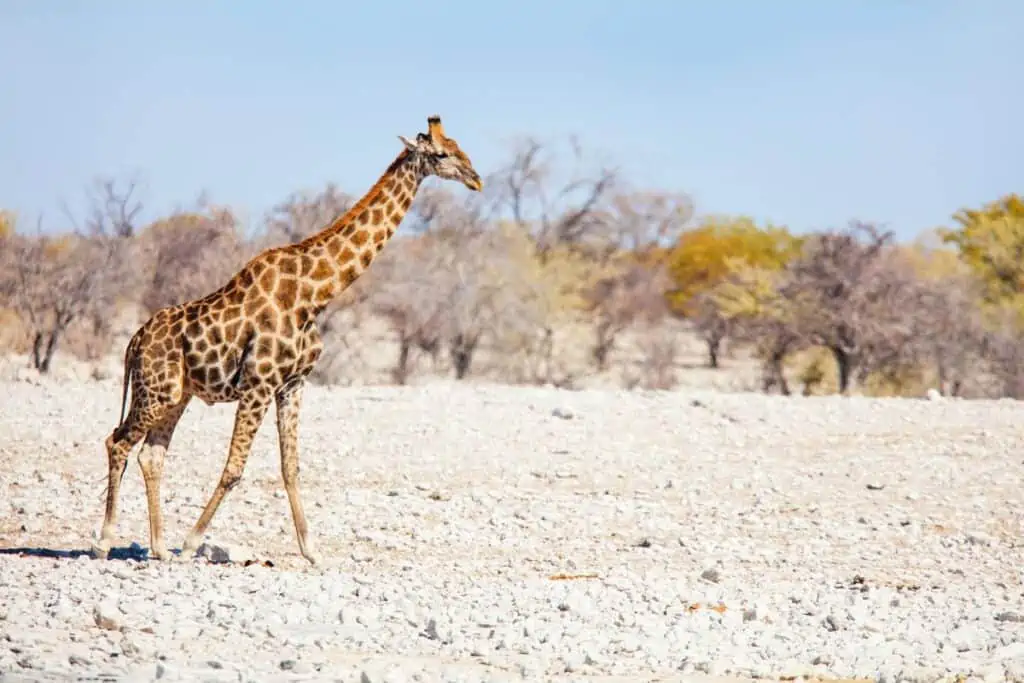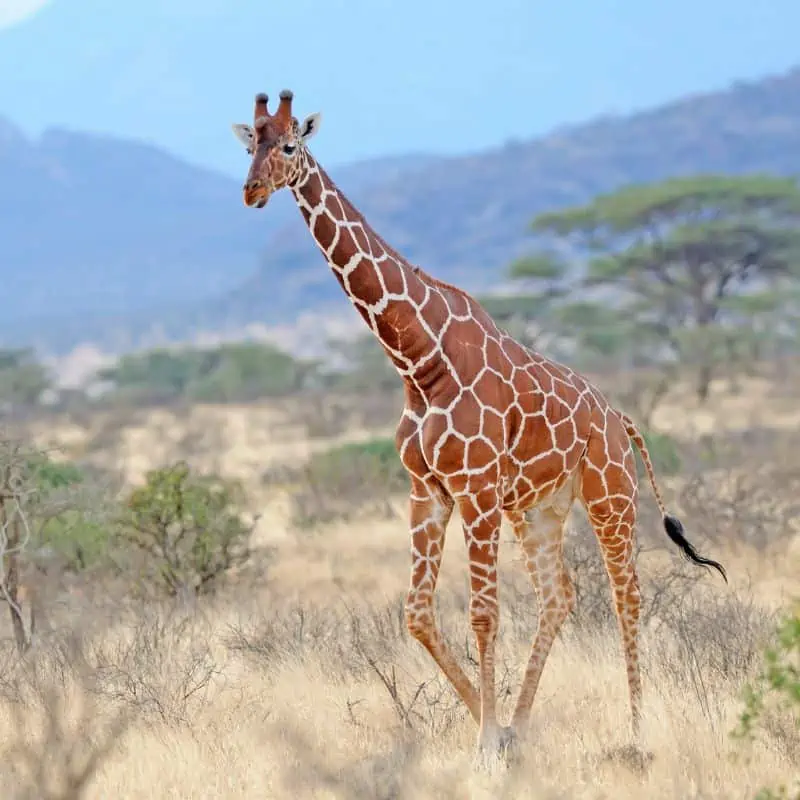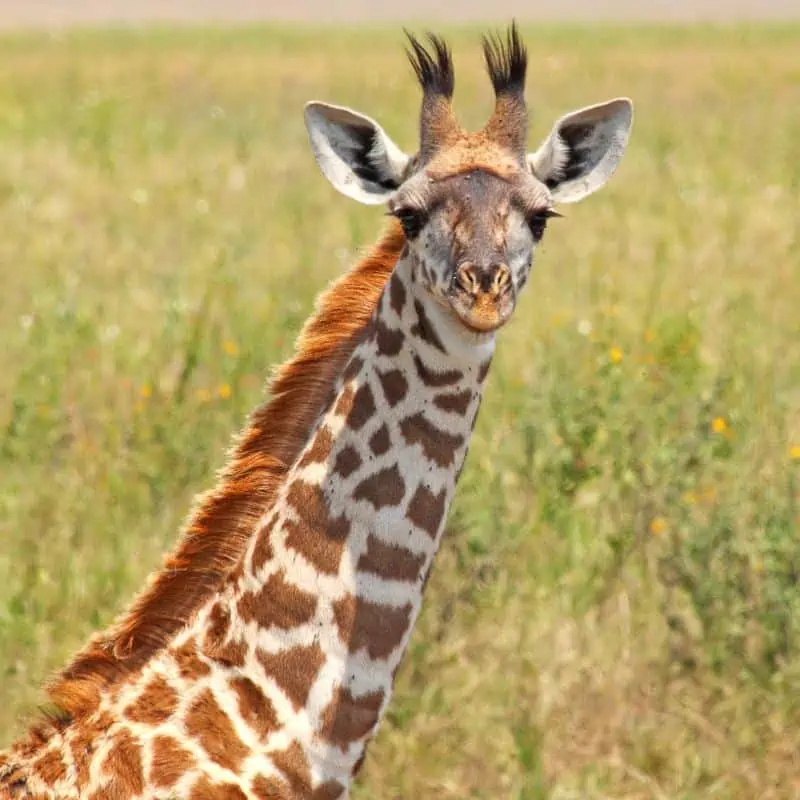Giraffes continue to amaze us with their majestic grace and beautiful patterns. But sadly, fewer and fewer continue to walk to earth. From poor habitats to poachers, these animals are in danger.
Giraffes are endangered and have been listed as Vulnerable on the International Union for Conservation of Nature (IUCN) Red List since 2016. Some giraffe species are critically endangered, with only a handful left in the wild.
In this article, we’ll discuss the reasons behind this drastic decline and what we can do to save these gentle giants.

Are Giraffes Endangered?
The number of giraffes in Africa during the 1980s was well over 155,000. Scientists and conservation groups estimate that that number has fallen almost 40%, leaving the total number of giraffes around 115,000.
Some areas that have been regarded as perfect giraffe habitats have seen numbers decrease by as much as 95%.
Today, there are four species and five subspecies/ecotypes of giraffes. The information on these animals will be used for conservation assessments and help to increase mandated protection.
The IUCN (International Union of Conservation of Nature) finds the giraffe vulnerable or facing a high risk of extinction. For some subspecies of giraffe, it’s even worse.
The Kordofan and Nubian Giraffes are critically endangered and face an extremely high risk of extinction.
How many giraffes are left in the world?
There are approximately 115,000 giraffes left in the world and only around 68,000 left in the wild. Some giraffe species are critically endangered and have far fewer numbers than other populations.
Here is a breakdown of the four species of giraffe and their subspecies:
The Northern giraffe has only 5,919 animals left.
The Northern giraffe is split into three subspecies:
- West African Giraffe
- Nubian Giraffe (critically endangered)
- Kordofan Giraffe (critically endangered)
The Southern Giraffe has 48,016 giraffes left.
The Southern Giraffe has two subspecies:
- South African Giraffe
- Angolan Giraffe
The Masai Giraffe has 45,402 animals left.
Its subspecies are:
- Luangwa Giraffe
The Reticulated Giraffe, which is endangered, has only 15,985 animals left.

Why Are Giraffes Endangered?
Unfortunately, these spectacular animals face endangerment for several reasons.
1. Loss of Habitat
One of the biggest threats to these animals is habitat loss. Some time ago, giraffes used to roam widely across the African Savanna. But now, they are only in a small number of communities across the continent.
In some countries, such as Mali, the giraffe is not seen at all.
In Niger, the population of giraffes is so isolated that officials have taken big steps to move the animals to safer ground.
One of the main reasons for the loss of habitat is that their woodlands have been turned into ranches and farms.
Because the charcoal industry in Africa is thriving, many folks make their living by harvesting trees and burning their wood to create charcoal. This is a problem for the giraffes that depend on those trees for nutrition.
2. War
Decades of civil war in Sudan have had an alarming impact on giraffes and other wildlife populations in the region.
In the 1980s, Sudan was home to 13,000 giraffes, but their population has depleted to only a few hundred.
The war increased poaching and wildlife tracking, while some Sudanese people have turned to giraffe bushmeat for survival.
3. Disease
Disease is a large threat to the number of giraffes, especially a skin disease widespread throughout the sub-Saharan. Giraffe Skin Disease affects animals with large greyish-brown skin lesions on the body.
The disease was found in Uganda, Kenya, Namibia, Tanzania, Zimbabwe, Botswana, and South Africa, though it is most prevalent in East Africa, where it has affected close to 90 percent of giraffes.
The skin lesions break out on different parts of the animal’s body, depending on its location.
In Uganda, the legions appear on the neck and shoulders, and in Tanzania, they seem to affect the giraffe’s legs.
Researchers aren’t sure if the disease is entirely fatal, but they do know that the disease makes giraffes more vulnerable to predators as they can jeopardize their ability to flee.
4. Poaching and Hunting
The giraffe population continues to face threats from poachers and hunters. Spears, poison arrows, and riffles are all used to kill giraffes. But one of the most common methods is wire snares attached to trees, which will capture the giraffe by its legs or neck, and the injuries can be fatal.
Poachers sell giraffe meat and parts and make up to 1,000 US dollars. Internet shoppers can find many products made from giraffe parts.
One of the most popular items is giraffe bone, which has since replaced elephant ivory for gun handles and knives.
People also make rugs and clothing from their hide and sell their taxidermied body parts.
In Tanzania, giraffe parts are often used in traditional medicine, and some are believed to cure AIDS.
5. Climate Change
Climate change continues to threaten not only the population of giraffes but many other kinds of wildlife in Africa.
Drought and extreme weather conditions mean giraffes must travel further to find food, leaving them more vulnerable to death and disease.
What can be done about endangered giraffes?

It’s up to us to do whatever we can to save the mighty giraffe.
Here are some things that can be done:
1. Relocate Them
Giraffes can not move through regions that compromise their survival, so it’s up to us to help them.
The Uganda Wildlife Authority has moved small groups of giraffes to protected areas in the hopes that they can thrive.
Communities in Kenya have also turned their land into conservation areas for giraffes, and the Kenya Wildlife Service offers training for rangers and veterinary help.
2. Anti Poaching Campaigns
Poaching must be stopped, and some organizations strive to do just that.
The International Anti-Poaching Federation (IAPF) is taking a strong approach to stop wildlife poaching in Africa.
Ranger programs are asking locals to defend giraffe habitats and arrest poachers without violence.
As knowledge about poaching gets out, everyday folks can help to stop it now and in the future by not buying any products made from giraffe parts.
3. Giraffe Orphanages
It’s very easy for giraffe calves to become orphans. Poaching, getting separated from the herd, death of their mother, and drought are all contributing factors.
Calves under a year are an easy target for predators such as hyenas or lions. Thankfully some establishments are out to help rescue these baby giraffes.
Orphanages are wonderful places where baby giraffes can hopefully be raised to adulthood and then returned to the wild.
Save Giraffes Now (SGN) has invested in orphanages in Zimbabwe and Botswana to help save baby giraffes left alone in the wild.
Final thoughts on giraffe’s endangered status
Giraffes are among the most iconic animals on earth, but their populations are in trouble.
There are many things we can do to help save them, from relocating them to protected areas to anti-poaching campaigns and investing in giraffe orphanages.
We must act now to ensure that these majestic creatures don’t go extinct.

